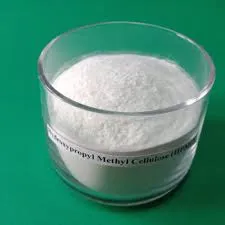
Sep . 28, 2024 18:54 Back to list
Hydroxypropyl Methylcellulose Powder Applications and Benefits in Various Industries
Hydroxypropyl Methylcellulose Powder Properties and Applications
Hydroxypropyl methylcellulose (HPMC) powder is a versatile cellulose ether, widely utilized across various industries due to its unique properties and functionalities. This non-ionic polymer is derived from cellulose, a natural polymer found in the cell walls of plants. HPMC is primarily used as a thickening agent, binding agent, and film-forming agent, making it an essential component in products ranging from pharmaceuticals to food, cosmetics, and construction materials.
Chemical Structure and Properties
HPMC is synthesized through the reaction of cellulose with propylene oxide and methyl chloride. The resulting compound exhibits a range of substitution patterns, with hydroxypropyl and methyl groups affecting its solubility and viscosity. One of the remarkable features of HPMC is its ability to dissolve in water, forming a clear gel-like solution. The degree of substitution and the molecular weight of HPMC can be tailored to achieve specific properties, allowing for a wide range of applications.
The solubility of HPMC in cold water distinguishes it from other cellulosic ethers. Its viscosity can be controlled by adjusting the concentration and molecular weight, making it suitable for various formulations. Additionally, HPMC is stable under different pH conditions and temperature variations, further enhancing its utility in diverse environments.
Applications in Pharmaceuticals
HPMC plays a critical role in the pharmaceutical industry. It is commonly used as a binder in tablet formulations, helping to improve the consistency and stability of the product. Moreover, HPMC serves as a controlled-release agent, enabling the gradual release of active ingredients, which is crucial for sustained medication effects. Its gel-forming properties are also harnessed in the production of ophthalmic solutions and gels, ensuring the delivery of medications in a stable and effective manner.
Role in Food Products
hydroxypropyl methylcellulose powder

In the food industry, HPMC is valued for its thickening and gelling capabilities. It is used in food products as a stabilizer and emulsifier, enhancing texture and mouthfeel. Additionally, HPMC is often incorporated into gluten-free recipes, where it helps imitate the properties of gluten, resulting in improved moisture retention and food structure. Its ability to withstand high temperatures also makes it suitable for use in processed foods.
Use in Cosmetics and Personal Care
The cosmetic industry benefits significantly from HPMC's properties. It functions as a thickener and stabilizer in creams, lotions, and gels, providing a desirable texture while preventing separation of ingredients. Furthermore, HPMC's non-ionic nature makes it suitable for sensitive skin formulations, as it minimizes the risk of irritation. Its film-forming capabilities also allow for the creation of long-lasting cosmetic products.
Contributions to Construction
In construction, HPMC is used as an additive in cement-based materials, improving workability and water retention. This addition enhances the application properties of mortars and plasters, making them easier to spread and reducing shrinkage during drying. The use of HPMC in construction materials also contributes to the sustainability of building practices, as it can improve the durability of finished products.
Conclusion
In summary, hydroxypropyl methylcellulose powder is an essential ingredient across multiple industries, serving various roles due to its unique properties. Its versatility as a thickener, emulsifier, binder, and film former makes it indispensable in pharmaceuticals, food, cosmetics, and construction. As industries continue to innovate and seek sustainable solutions, the demand for HPMC is likely to grow, further establishing it as a critical component in modern formulations.
-
Versatile Hpmc Uses in Different Industries
NewsJun.19,2025
-
Redispersible Powder's Role in Enhancing Durability of Construction Products
NewsJun.19,2025
-
Hydroxyethyl Cellulose Applications Driving Green Industrial Processes
NewsJun.19,2025
-
Exploring Different Redispersible Polymer Powder
NewsJun.19,2025
-
Choosing the Right Mortar Bonding Agent
NewsJun.19,2025
-
Applications and Significance of China Hpmc in Modern Industries
NewsJun.19,2025







